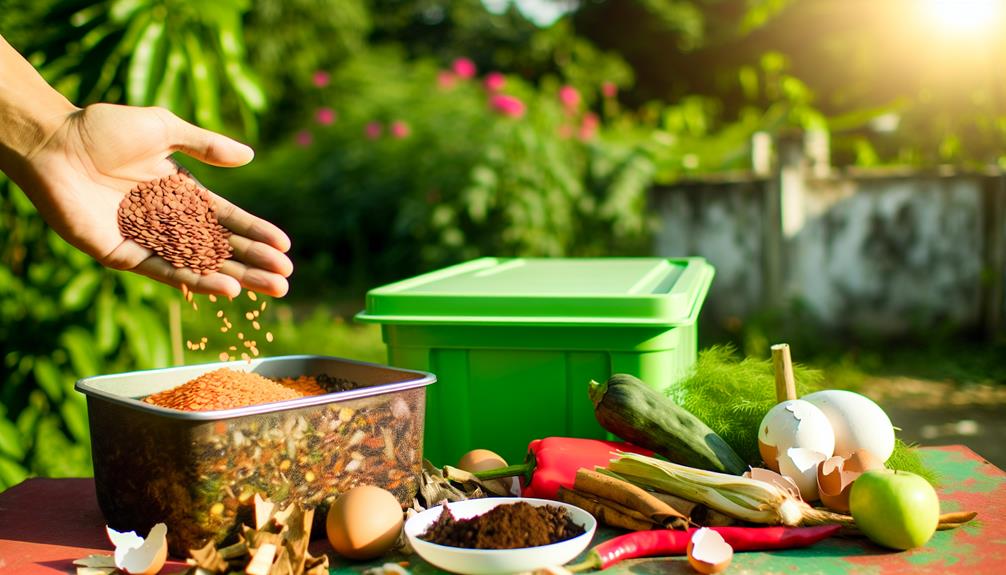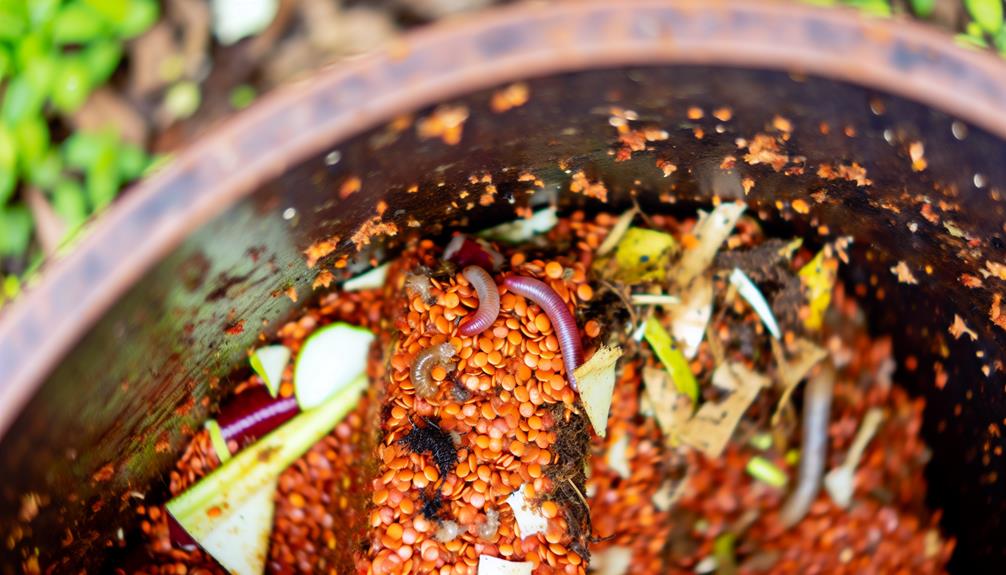

Yes, you can compost red lentils to enrich your soil with essential nutrients. Red lentils decompose to release nitrogen, benefiting plant tissue growth. For best results, cook or soak the lentils before adding them to your compost pile. Balance your compost by mixing one-third green materials like lentils with two-thirds brown materials such as leaves.
Guarantee proper aeration by turning the pile regularly, and monitor moisture levels to prevent odor and pest issues. Covering the compost can help manage moisture. Understanding these steps will enhance your composting process and improve the health of your garden. Let’s explore further.
Red lentils are packed with essential nutrients that make them an excellent addition to your compost. By incorporating red lentils into your compost pile, you’re providing a rich source of protein and carbohydrates that can break down and nourish your soil. Their high protein content is particularly beneficial, as proteins are essential for the growth and repair of plant tissues. When these proteins decompose, they release nitrogen, an important nutrient that plants need to thrive.
Additionally, red lentils have significant carbohydrate levels, which contribute to the energy supply for microorganisms in your compost. These microorganisms are vital for breaking down organic matter, turning your compost pile into nutrient-rich humus. Carbohydrates decompose into simpler sugars, which further fuel the microorganisms, speeding up the composting process.
To get the most out of red lentils in your compost, it’s helpful to mix them with other green materials like vegetable scraps and grass clippings. This balanced mixture of green and brown materials ensures an ideal carbon-to-nitrogen ratio, enhancing the efficiency of the composting process.
Also Read: Can You Compost Ice Cream?
Composting red lentils provides several advantages you’ll want to take into account.
It creates nutrient-rich soil, reduces household waste, and improves plant health.
Transforming kitchen scraps into nutrient-rich soil offers a sustainable way to enrich your garden and reduce waste. When you compost red lentils and other organic matter, you’re creating a rich, fertile environment for your plants. This process, known as soil enrichment, involves breaking down these materials into a form that plants can easily absorb. Your garden will thrive with the nutrients provided by composted red lentils.
Using compost in your garden not only boosts plant growth but also improves soil structure. It increases the soil’s ability to retain moisture and enhance aeration, making it easier for roots to grow. Here’s a table to help you understand the benefits of composting red lentils:
| Benefit | Description | Impact |
|---|---|---|
| Soil Enrichment | Adds essential nutrients to the soil | Healthier, more robust plant growth |
| Organic Matter | Breaks down into humus, enriching the soil | Improved soil structure and fertility |
| Moisture Retention | Enhances the soil’s ability to retain water | Less frequent watering needed |
When you compost red lentils, you greatly reduce the amount of household waste that ends up in landfills. This simple act contributes to sustainable living by turning food scraps into valuable compost instead of adding to the growing waste problem. By composting your red lentils, you help in waste reduction and make a positive impact on the environment.
To start composting red lentils, gather your kitchen scraps and place them in a compost bin. Mix them with other green materials like vegetable peelings and brown materials such as leaves or cardboard. Make sure to keep your compost pile balanced by maintaining an equal ratio of green to brown materials. Aerate the compost regularly to speed up the decomposition process.
Joining a community garden or a local composting group can enhance your composting efforts. Sharing your experiences and learning from others fosters a sense of belonging and collective responsibility. Additionally, many communities offer composting workshops that provide valuable tips and techniques for effective composting.
By turning red lentils and other kitchen scraps into compost, you not only reduce waste but also greatly enhance the health of your plants. Composting enriches the soil with important nutrients, improving soil fertility, which is essential for robust plant growth. When you add compost to your garden, you’re providing a slow-release source of nutrients that plants can absorb over time, leading to stronger and healthier growth.
Moreover, composting boosts plant immunity. The organic matter in compost helps improve soil structure, which in turn enhances root development and water retention. Healthy roots mean plants can access water and nutrients more efficiently, making them more resilient against diseases and pests.
To maximize these benefits, make sure your compost pile has a balanced mix of green (nitrogen-rich) and brown (carbon-rich) materials. Red lentils fall under green materials, contributing essential nitrogen to the compost.
Regularly turning the compost pile will aerate it, speeding up decomposition and ensuring a uniform blend of nutrients.
Also Read: Can You Compost Mail?
When composting red lentils, you’ll need to manage a few potential challenges.
Pay close attention to moisture control, as too much or too little water can affect the composting process.
Additionally, keep odor and pest issues in check with proper compost maintenance techniques.
Maintaining the right moisture level in your compost pile is essential for effectively composting red lentils. Too much moisture can lead to leachate production, which can create a soggy, anaerobic environment that hampers decomposition. Conversely, too little moisture can slow down the composting process and make it hard for microorganisms to thrive. Striking the right balance is key.
Moisture Control Tips:
| Moisture Issue | Solution |
|---|---|
| Too much moisture | Add dry materials like shredded paper or straw |
| Too little moisture | Sprinkle water evenly over the pile |
| Poor aeration | Turn the compost regularly to improve airflow |
| Uneven moisture | Mix the pile thoroughly to distribute moisture |
Use these strategies to maintain the ideal moisture level in your compost. Implementing effective aeration techniques, such as turning the pile with a pitchfork, helps prevent excess moisture and ensures oxygen reaches all layers. This promotes efficient decomposition and reduces the risk of leachate production.
Even with proper moisture control, you may still encounter unpleasant odors while composting red lentils. Don’t worry; you’re not alone in this. Let’s tackle this together by focusing on air circulation and covering methods.
First, make sure your compost pile has good air circulation. Turn the pile regularly, at least once a week. This action introduces oxygen, helping aerobic bacteria break down the red lentils efficiently, reducing the chance of odors. You could also incorporate materials like straw or shredded newspaper to improve airflow within the pile.
Next, consider effective covering methods. Use a layer of dry leaves, sawdust, or finished compost to cover fresh red lentil additions. This layer acts as a bio-filter, trapping odors and promoting a cleaner compost environment.
Moreover, avoid adding too many red lentils at once. Balance them with carbon-rich materials like cardboard or dead leaves to maintain the right composting ratio. If you notice persistent odors, double-check that your pile isn’t too wet and adjust accordingly.
Also Read: Can You Compost Rust?
Pests can quickly become a nuisance in your compost pile if red lentils aren’t managed properly. To avoid rodent infestations, consider where you place your compost bin. A well-chosen compost bin location can make a significant difference. Situate your bin on a solid surface, like concrete, to make it harder for rodents to burrow underneath. Also, make sure it’s away from your house or any outdoor dining areas to prevent attracting pests to your living space.
Here’s a quick guide to help visualize pest prevention strategies:
| Issue | Solution |
|---|---|
| Rodent infestations | Use a rodent-proof bin |
| Odor attraction | Cover with a layer of brown material |
| Poor bin location | Place on solid surface |
| Food scraps exposed | Bury under existing compost |
Maintaining a balanced compost pile is essential. Mix red lentils with brown materials like leaves or straw to reduce odors that attract pests. Always bury food scraps under a layer of existing compost to keep them out of sight and smell. Regularly turn your compost to promote aeration and discourage pests from settling in. By taking these steps, you’ll keep your compost pile healthy and pest-free, fostering a sense of community in your garden.
Before you start composting red lentils, gather all necessary materials and tools to guarantee a smooth process. First, make sure you have a clean workspace. The important cleaning process is vital because any contaminants can affect your compost quality. Wash your hands, clean your tools, and sanitize any surfaces you’ll be using.
Next, consider your storage methods. If you’re not composting the lentils immediately, store them in a cool, dry place to prevent spoilage. Use airtight containers to keep moisture and pests at bay. Label these containers with the date of storage to keep track of their freshness.
Once your materials are ready, sort through the red lentils to remove any foreign objects or spoiled lentils. Spoiled lentils can introduce unwanted bacteria to your compost pile.
Now, pre-soak the lentils in water for a few hours. This step will soften them, making them break down more quickly in the compost. Drain the water thoroughly after soaking.
Gather your composting tools like a compost bin, a pitchfork, and gloves. Having everything on hand will streamline the process, ensuring you can focus on creating high-quality compost.
Adding red lentils to your compost pile can enrich it with essential nutrients, promoting healthy decomposition. When you add red lentils to your compost bin, you’re contributing valuable nitrogen, which is important for the breakdown of organic materials. This helps create a nutrient-rich compost that your garden will love.

Before you toss your lentils into the compost bin, make sure they’re cooked or soaked. This step allows them to break down more easily and speeds up the composting process. Raw lentil seeds can take longer to decompose and may even sprout, which you likely want to avoid in your compost.
To add red lentils effectively, mix them evenly with other compost materials. This promotes a balanced decomposition process. You don’t want clumps of lentils sitting together, as they can become compacted and create anaerobic conditions, which can lead to unpleasant odors.
Remember to turn your compost regularly. This aerates the pile, ensuring that the lentil seeds and other materials decompose efficiently. By doing so, you’ll help maintain a healthy compost bin, ultimately producing rich, fertile compost for your garden. Your plants will thank you for it!
Also Read: Can You Compost Rust?
Ensuring the right balance between green and brown materials in your compost pile is essential for achieving efficient decomposition. Think of green materials as those rich in nitrogen, like your red lentils, vegetable scraps, and coffee grounds. Brown materials, on the other hand, are rich in carbon and include items like dried leaves, straw, and cardboard.
To maintain the ideal carbon ratio, aim for about 25-30 parts carbon to 1 part nitrogen. A good rule of thumb is to add one-third green materials and two-thirds brown materials. This balance helps maintain proper nitrogen levels, ensuring that your compost doesn’t become too wet or too dry, which can impede the decomposition process.
When adding red lentils to your compost, remember they’re a green material. To keep your pile balanced, add an appropriate amount of brown materials, like shredded newspaper or dried leaves. Mixing these materials thoroughly will promote aeration and microbial activity, speeding up decomposition.
Also Read: Can You Compost Carrot Peel?
To monitor decomposition effectively, keep an eye on temperature, moisture levels, and the overall appearance of your compost pile. Start by checking the temperature regularly. A well-maintained compost pile should heat up to between 135°F and 160°F. This indicates active microbial activity, which accelerates the decomposition rate.

If the temperature drops considerably, it might be time to turn your pile or add more green materials like your red lentils.
Next, focus on moisture. Your compost should be as damp as a wrung-out sponge. Too much moisture can drown the microorganisms, while too little can slow down their activity. Use a tarp to cover your pile if it’s too wet or add water if it’s too dry.
Also Read: Can You Compost Cardboard Tubes?
In wrapping up, remember that successful composting of red lentils depends on maintaining the right conditions and monitoring the process closely. Ensuring the right balance of green and brown materials, proper moisture, and adequate aeration will help your red lentils break down efficiently in your compost bin.
Here’s a quick reference table to guide you:
| Factor | Ideal Condition | Tip |
|---|---|---|
| Green to Brown Ratio | 1:2 to 1:3 | Add dry leaves or paper |
| Moisture Level | Damp, like a wrung-out sponge | Water sparingly |
| Aeration | Regular turning | Turn weekly |
| Composting Duration | 2-6 months | Patience is key |
Keep an eye on the composting duration as it can vary based on your local climate, the size of the compost bin, and how often you turn the pile. Regularly check for any foul odors, which could indicate a need for more brown material or better aeration.
Yes, you can compost cooked red lentils! They provide valuable nutrient contribution and help maintain moisture balance in your compost. Including them fosters a sense of community in sustainable living, enhancing everyone’s composting experience.
Red lentils can attract pests if not properly managed. For effective pest prevention, guarantee proper compost aeration and cover food scraps. You’re part of a community that values sustainability, so keep your compost healthy and pest-free!
Red lentils’ decomposition rate in compost is quick, usually within a few weeks. Their high nitrogen content helps maintain the carbon-nitrogen balance, ensuring efficient composting. You’ll feel great contributing to a sustainable, eco-friendly community!
You don’t need to rinse red lentils before composting them. Their nutrient content will benefit your compost. One of the best composting tips is to keep it simple and let nature do its work.
Yes, you can compost red lentil sprouts. Their sprout benefits include high nutrient content, which enriches your compost pile. You’ll be contributing to a healthier garden and connecting with others who value sustainable practices.
To compost red lentils effectively, make sure you prepare them properly and balance your green and brown materials.
Monitor the decomposition process to maintain ideal conditions.
Remember, red lentils add valuable nutrients to your compost, boosting its quality.
By following these guidelines, you’ll not only reduce waste but also enrich your garden soil.
Happy composting!
